Promoting University–Community Alliances in the Experiential Learning Activities of Agricultural Extension Postgraduate Students at the University of Fort Hare, South Africa
Abstract
1. Introduction
2. Literature Review
3. Project Methodology
3.1. Background
3.2. Approach
- Stages
3.3. Data Collection
4. Results
5. Project Activities
5.1. Project 1—Mhlobo Mbane Poultry Project Rural Engagement
5.1.1. Background
5.1.2. Results of the Situation Analysis
5.1.3. Strategic Ways of Addressing Some of the Challenges
- re-fencing of the farm perimeter;
- repair of the leaking roofs and exposed places;
- general cleaning of the pens and the surroundings to improve bio-security;
- the use of a footbath with disinfectant;
- reduction in the number of visitors to the poultry house;
- steps around diseases and pest control, prophylactic and treatment;
- actions around farm security;
- steps on community policing to reduce the theft of birds and poultry vandalisation.
5.2. Project 2—Gwebindlala Agricultural Extension Project (2018 Edition)
5.2.1. Background
5.2.2. Results of the Situation Analysis (2018 Class)
5.2.3. Strategic Ways of Addressing Some of the Challenges
- the development and use of grey water for the school’s garden;
- the training of learners on simple techniques of home gardening;
- the establishment of a vegetable garden on the uncultivated land;
- re-cultivation of the greenhouse garden;
- raising funds for the purchase of simple farm tools and a hosepipe.
5.2.4. Results of Situation Analysis (2019 Class)
5.2.5. Strategic Ways of Addressing Some of the Challenges
5.3. Project 3—Vuk’uhambe Agricultural Community Engagement
5.3.1. Background
5.3.2. Results of the Situation Analysis
5.3.3. Strategic Ways of Addressing Some of the Challenges
5.4. Project 4—Bambanani Community Project
5.4.1. Background
5.4.2. Report of the Situation Analysis
5.4.3. Strategic Way of Addressing Some of the Challenges
5.5. Project 5—Lovedale Community Project
5.5.1. Background
5.5.2. Report of the Situation Analysis
5.5.3. Strategic Ways of Addressing Some of the Challenges
6. Discussion
- enhancing poultry biosecurity measures;
- construction of fences;
- the pooling and use of available local resources to implement suggested technical solutions;
- land preparation, seedbed making, planting, nutrient conservation, fertiliser and pesticide applications, irrigation and harvesting;
- practical use of farm equipment;
- training and providing advisory services to community participants;
- interpersonal skills, critical thinking, and enhanced initiative for problem solving.
7. Conclusions
Author Contributions
Funding
Institutional Review Board Statement
Informed Consent Statement
Data Availability Statement
Acknowledgments
Conflicts of Interest
References
- Strier, R. Fields of paradox: University–community partnerships. High. Educ. 2014, 68, 155–165. [Google Scholar] [CrossRef]
- Strier, R.; Shechter, D. Visualizing access: Knowledge development in university–community partnerships. High. Educ. 2016, 71, 343–359. [Google Scholar] [CrossRef]
- Porter, L. Who is learning what from whom? The beautiful messiness of learning partnerships. Plan. Theory Pract. 2015, 16, 409–414. [Google Scholar] [CrossRef]
- Lewis, L.A.; Kusmaul, N.; Elze, D.; Butler, L. The role of field education in a university–community partnership aimed at curriculum transformation. J. Soc. Work Educ. 2016, 52, 186–197. [Google Scholar] [CrossRef]
- Bitso, C.; Silbert, P. Towards functional school libraries: Supporting library assistants in under-resourced schools through a university-community-school partnership. S. Afr. J. Libr. Inf. Sci. 2015, 81, 53–62. [Google Scholar]
- Bassa, F.; Petzer, B.; Winkler, T. At the coalface, take 2: Lessons from students’ critical reflections. Plan. Theory Pract. 2015, 16, 423–426. [Google Scholar]
- Macchiarella, N.D.; Mirot, A.J. Scenario development for unmanned aircraft system simulation-based immersive experiential learning. J. Aviat. Educ. Res. 2018, 28, 63–79. [Google Scholar] [CrossRef][Green Version]
- Khapre, M.; Gupta, M.; Kishore, S. Experiential learning in epidemiology for medical undergraduates: A mixed-method approach. J. Clin. Diagn. Res. 2019, 13, 7–12. [Google Scholar]
- Fede, J.H.; Gorman, K.S.; Cimini, M.E. Student employment as a model for experiential learning. J. Exp. Educ. 2018, 41, 107–124. [Google Scholar] [CrossRef]
- Kearney, J.; Wood, L.; Zuber-Skerritt, O. Community university partnerships: Using participatory action learning and action research (PALAR)’. Gatew. Int. J. Community Res. Engag. 2013, 6, 113–130. [Google Scholar] [CrossRef]
- Kindred, J.; Petrescu, C. Expectations versus reality in a university–community partnership: A case study. Volunt. Int. J. Volunt. Nonprofit Organ. 2015, 26, 823–845. [Google Scholar] [CrossRef]
- Parker, M.; Templin, T.; Setiawan, C. What has been learned from school-university partnerships. J. Phys. Educ. Recreat. Dance 2012, 83, 32–35. [Google Scholar] [CrossRef]
- Mastuti, S.; Masse, A.; Tasruddin, R. University and community partnerships in South Sulawesi, Indonesia: Enhancing community capacity and promoting democratic governance. Gatew. Int. J. Community Res. Engag. 2014, 7, 164–173. [Google Scholar] [CrossRef]
- Patterson, D.A.; Cronley, C.; West, S.; Lantz, J. Social justice manifest: A university–community partnership to promote the individual right to housing. J. Soc. Work Educ. 2014, 50, 234–246. [Google Scholar] [CrossRef]
- Fullerton, C.A. University-community partnerships as a pathway to rural development: Benefits of an Ontario land use planning project. J. Rural Community Dev. 2015, 10, 56–71. [Google Scholar]
- Korzun, M.; Alexander, C.; Cluskey-Belanger, L.J.; Fudger, D.; Needham, L.; Vsetula, K.; Williamson, D.; Gillis., D. The farm to fork project: Community-engaged scholarship from community partners’ perspective. Gatew. Int. J. Community Res. Engag. 2014, 7, 101–115. [Google Scholar] [CrossRef]
- Jewell, J.R.; Owens, A.P. Confronting carceral power through experiential learning in macro social work practice. J. Soc. Work Educ. 2017, 36, 403–413. [Google Scholar] [CrossRef]
- Barron, D.; Khosa, D.; Jones-Bitton, A. Experiential learning in primary care: Impact on veterinary students’ communication confidence. J. Exp. Educ. 2017, 40, 349–365. [Google Scholar] [CrossRef]
- Peterson, K.; Kolb, D.A. Expanding awareness and contact through experiential learning. Gestalt Rev. 2018, 22, 226–248. [Google Scholar] [CrossRef]
- Kuk, H.S.; Holst., D.J. A dissection of experiential learning theory: Alternative approaches to reflection. Adult Learn. 2018, 29, 150–157. [Google Scholar] [CrossRef]
- Cornell, R.M.; Johnson, C.B.; Schwartz, W.C., Jr. Enhancing student experiential learning with structured interviews. J. Educ. Bus. 2013, 88, 136–146. [Google Scholar] [CrossRef]
- Gross, Z.; Rutland, S.D. Experiential learning in informal educational settings. Int. Rev. Educ. 2017, 63, 1–8. [Google Scholar] [CrossRef]
- Murphy, L.; Wilson, J.; Greenberg, S. Equine-assisted experiential learning in occupational therapy education. J. Exp. Educ. 2017, 40, 366–376. [Google Scholar] [CrossRef]
- Roberts, J. From the editor: The possibilities and limitations of experiential learning research in higher education. J. Exp. Educ. 2018, 41, 3–7. [Google Scholar] [CrossRef]
- Slade, C.; Butt, A.; Rosiera, J.; Perkins, T. Experiential learning partnerships in Australian and New Zealand higher education planning programmes. Plan. Theory Pract. 2015, 16, 409–417. [Google Scholar]
- Kolb, D.A. Experiential Learning: Experience as the Source of Learning and Development, 1st ed.; Prentice Hall: Englewood Cliffs, NJ, USA, 1984. [Google Scholar]
- Kolb, A.Y.; Kolb, D.A. Experiential learning theory: A dynamic, holistic approach to management learning, education and development. Armstrong Manag. Learn. Educ. Develop. 2008, 42, 42–68. [Google Scholar]
- Passarelli, A.M.; Kolb, D.A. Using Experiential Learning Theory to Promote Student Learning and Development in Programmes of Education Abroad; ORBH Working Paper, 9/13/2011.Stylus; Publishing LLC: Sterling, VA, USA; Available online: https://weatherhead.case.edu/departments/organizational-behavior/workingPapers/WP-11-03.pdf (accessed on 5 February 2021).
- Yardley, S.; Teunissen, P.W.; Dornan, T. Experiential learning: Transforming theory into practice. Med. Teach. 2012, 34, 161–164. [Google Scholar] [CrossRef]
- McLeod, S.A. Kolb: Learning Styles. 2013. Available online: https://www.simplypsychology.org/learning-kolb.html (accessed on 28 January 2021).
- Canboy, B.; Montalvo, A.; Buganza, M.C.; Emmerling, R.J. Module 9: A new course to help students develop interdisciplinary projects using the framework of experiential learning theory. Innov. Educ. Teach. Int. 2016, 53, 445–457. [Google Scholar] [CrossRef]
- Page, M.B.; Margolis, R.L. Co-creating collaborative leadership learning environments: Using adult learning principles and a coach approach. New Dir. Adult Cont. Educ. 2017, 156, 77–87. [Google Scholar] [CrossRef]
- Percy, R. The experiential learning cycle and its application towards the transformation of governmental extension services in sub-Saharan Africa. Int. J. Lifelong Educ. 1999, 18, 370–384. [Google Scholar] [CrossRef]
- Dalrymple, R.L.; Kemp, D.J.; Flores-Moreno, H.; Laffan, S.W.; White, T.E.; Hemmings, F.A.; Moles, A.T. Macroecological patterns in flower colour are shaped by both biotic and abiotic factors. New Phytol. 2020, 228, 1972–1985. [Google Scholar] [CrossRef] [PubMed]
- United Nations General Assembly. Report of the World Commission on Environment and Development: Our Common Future; United Nations General Assembly, Development and International Co-operation, Environment: Oslo, Norway, 1987. [Google Scholar]
- Biju, P.; Vinayagamurthy, P.; Reeja, P.S. Impact of training knowledge empowerment in natural resource management in pmay-life at Kottayam municipality, Kerala. Palarchs J. Arch. Egyptol. 2020, 17, 3691–3695. [Google Scholar]
- Mojarad, A.A.S.; Atashbari, V.; Tantau, A. Challenges for sustainable development strategies in oil and gas industries. In Proceedings of the International Conference on Business Excellence, Bucharest, Romania, 22–23 March 2018; Volume 12, pp. 626–638. [Google Scholar]
- Drysdale, R.E.; Urmilla, B.; Mosa, M. Coping through a drought: The association between child nutritional status and household food insecurity in the district of iLembe, South Africa. Public Health Nutr. 2021, 24, 1052–1065. [Google Scholar] [CrossRef]
- Statistics South Africa (Stats SA). Quarterly Labour Force Survey, Quarter 1; Statistics South Africa: Pretoria, South Africa, 2018.
- UNDP. Sustainable Development Goals in Action. 2021. Available online: https://www.undp.org/sustainable-development-goals (accessed on 6 May 2021).
- Wills, G.; van der Berg, S.; Patel, L.; Mpeta, B. Household Resource Flows and Food Poverty During South Africa’s Lockdown: Short-Term Policy Implications for Three Channels of Social Protection; Department of Economics, University of Stellenbosch: Stellenbosch, South Africa, 2020. [Google Scholar]
- Pasara, M.T.; Rufaro, G. Causality effects among gross capital formation, unemployment and economic growth in South Africa. Economies 2020, 8, 26. [Google Scholar] [CrossRef]
- Amaya, A.B.; Yeates, N. Participatory Action Research: New Uses, New Contexts, New Challenges; PRARI Working Paper; 2015; pp. 15–16. Available online: https://www.open.ac.uk/socialsciences/prari/files/working_paper_6_en.pdf (accessed on 5 February 2021).
- MacDonald, C. Understanding participatory action research: A qualitative research methodology option. Can. J. Action Res. 2012, 13, 34–50. [Google Scholar]
- Schensul, S.L.; Schensul, J.J.; LeCompte, M.D. Essential ethnographic methods: Observations, interviews, and questionnaires. In Ethnographer’s Toolkit; Book 2; AltaMira Press: Walnut Creek, CA, USA, 1999. [Google Scholar]
- Chan, C.K.Y. Exploring an experiential learning project through Kolb’s learning theory using a qualitative research method. Eur. J. Eng. Educ. 2012, 37, 405–415. [Google Scholar] [CrossRef]
- Baker, M.A.; Robinson, J.S.; Kolb, D.A. Aligning Kolb’s experiential learning theory with a comprehensive agricultural education model. J. Agric. Educ. 2012, 53, 1–16. [Google Scholar] [CrossRef]
- Friman, M.; Schreiber, D.; Syrjänen, R.; Kokkonen, E.; Mutanen, A.; Salminen, J. Steering sustainable development in higher education—Outcomes from Brazil and Finland. J. Clean. Prod. 2018, 186, 364–372. [Google Scholar] [CrossRef]
- Boons, F.; Laasch, O. Business models for sustainable development: A process perspective. J. Bus. Models 2019, 7, 9–12. [Google Scholar]
- Lijadi, A.A.; van Schalkwyk, G.J. Online Facebook focus group research of hard-to-reach participants. Int. J. Qual. Methods 2015, 14, 1–9. [Google Scholar] [CrossRef]
- Eghdam, A.; Hamidi, U.; Bartfai, A.; Koch, S. Facebook as communication support for persons with potential mild acquired cognitive impairment: A content and social network analysis study. PLoS ONE 2018, 13, e0191878. [Google Scholar]
- Ferris, A.L.; Hollenbaugh, E.E. A uses and gratifications approach to exploring antecedents to Facebook dependency. J. Broadcast. Electron. Media 2018, 62, 51–70. [Google Scholar] [CrossRef]
- Dalsgaard, C. Students’ educational use of Facebook groups. Educ. Media Int. 2016, 53, 261–273. [Google Scholar] [CrossRef][Green Version]
- Callaghan, G.; Fribbance, I. The use of Facebook to build a community for distance learning students: A case study from the open university. Open Learn. J. Open Distance e-Learn. 2016, 31, 260–272. [Google Scholar] [CrossRef]
- Mccracken, A. Tumblr youth subcultures and media engagement. Cine. J. 2017, 57, 151–161. [Google Scholar] [CrossRef]
- Voivonta, T.; Avraamidou, L. Facebook: A potentially valuable educational tool? Educ. Media Int. 2018, 55, 34–48. [Google Scholar] [CrossRef]
- Goodall, M.; Moore, E. Integrating the Sustainable Development Goals into teaching, research, operations, and service: A case report of Yale University. Sustain. J. Rec. 2019, 12, 93–96. [Google Scholar] [CrossRef]
- López, I.L.; Bote, M.; Rives, L.M.; Bañón, A.R. Higher education institutions as a transformation platform under the sustainable development goals framework. Eur. J. Sustain. Dev. 2019, 8, 306. [Google Scholar] [CrossRef]
- Schopp, K.; Bornemann, M.; Potthast, T. The Whole-Institution Approach at the University of Tübingen: Sustainable Development Set in Practice. Sustainability 2020, 12, 861. [Google Scholar] [CrossRef]
- Kolb, A.Y.; Kolb, D.A. Learning styles and learning spaces: Enhancing experiential learning in higher education. Acad. Manag. Learn. Educ. 2005, 4, 193–212. [Google Scholar] [CrossRef]
- Baker, M.A.; Robinson, J.S. The effects of Kolb’s experiential learning model on successful intelligence in secondary agriculture students. J. Agric. Educ. 2016, 57, 29–144. [Google Scholar] [CrossRef]
- Strier, R. The construction of university-community partnerships: Entangled perspectives. High. Educ. 2011, 62, 81–97. [Google Scholar] [CrossRef]
- Gimpel, N.; Kindratt, T.; Dawson, A.; Pagels, P. Community action research track: Community-based participatory research and service-learning experiences for medical students. Perspect. Med. Educ. 2018, 7, 139–143. [Google Scholar] [CrossRef] [PubMed]
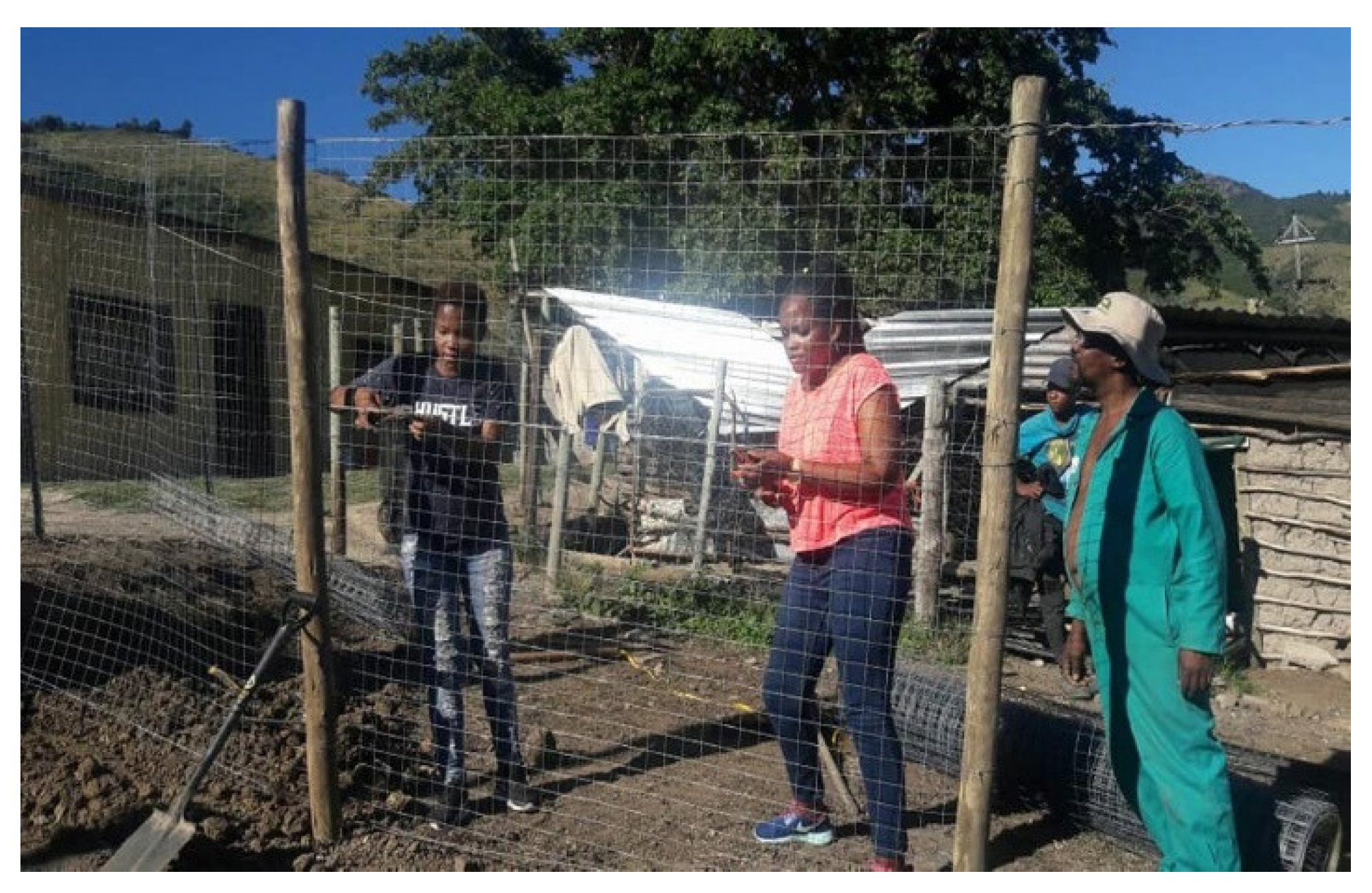

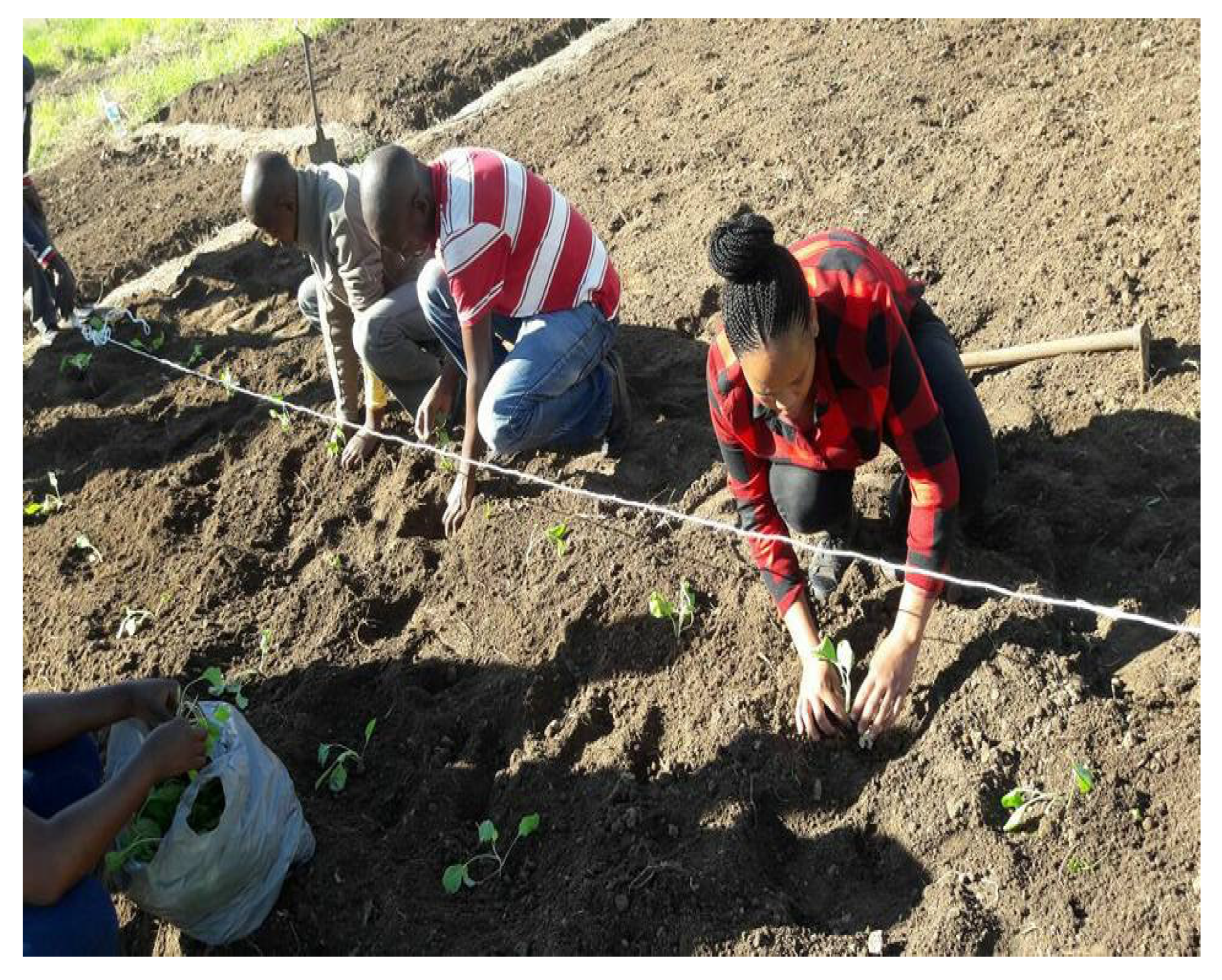
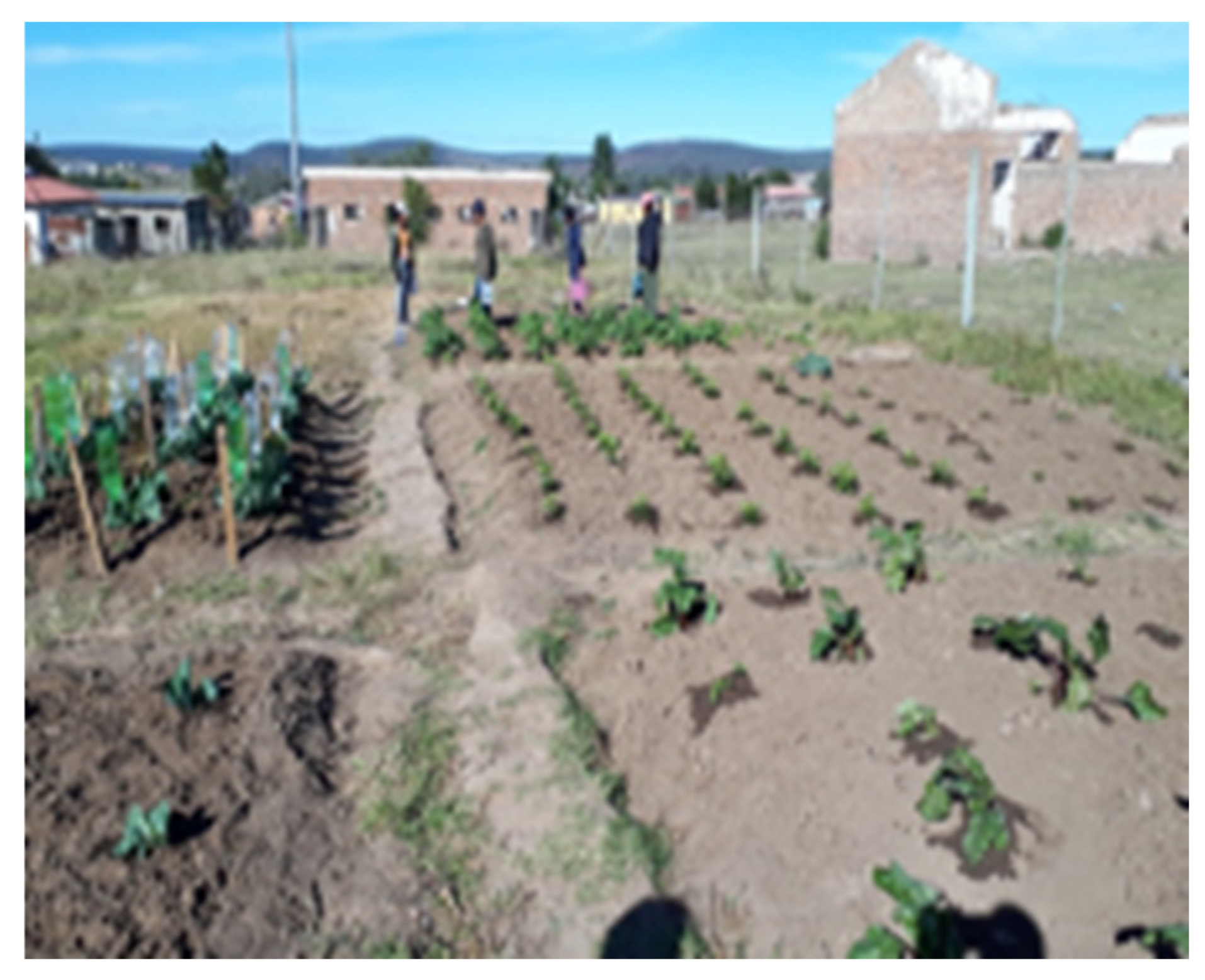
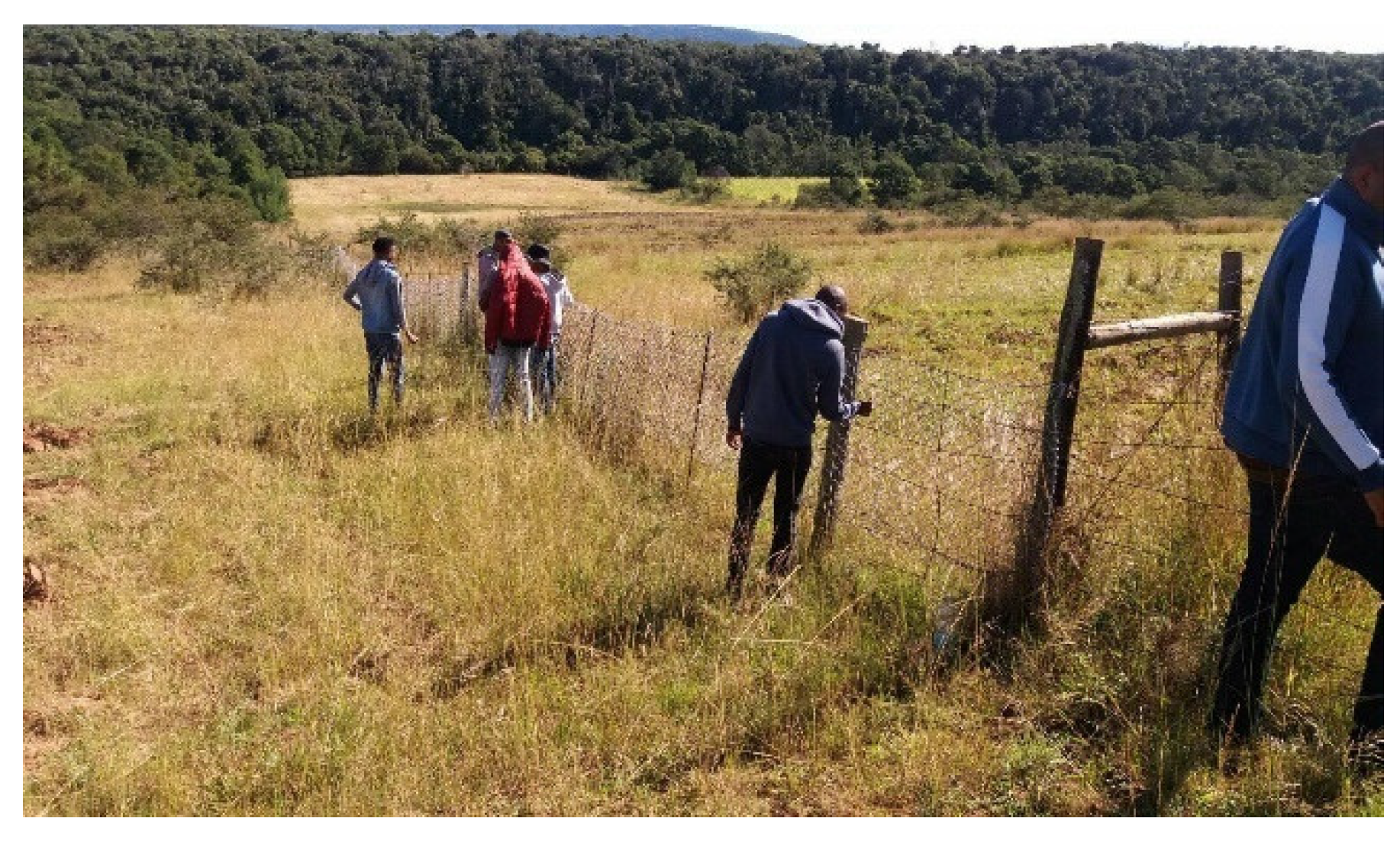

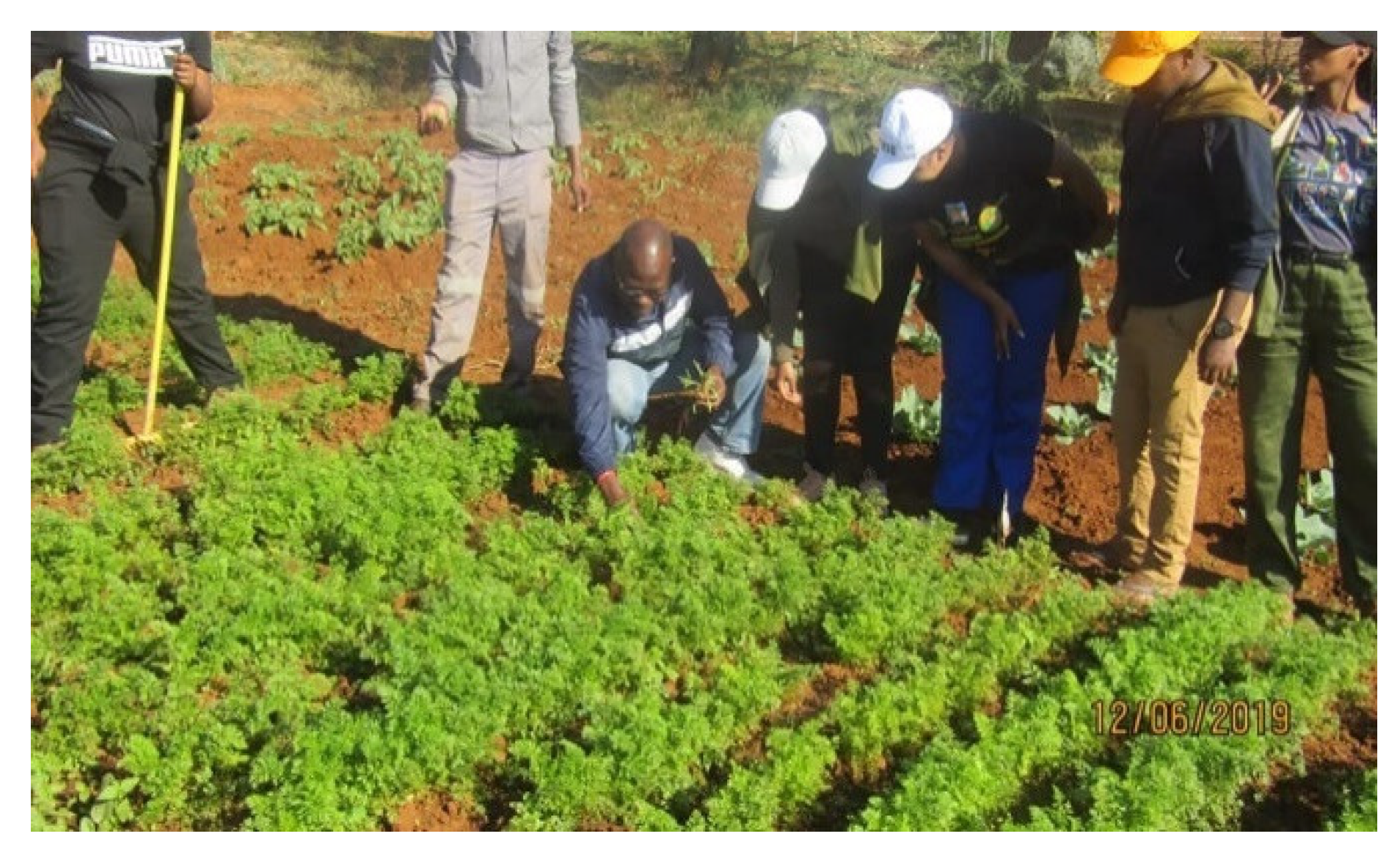
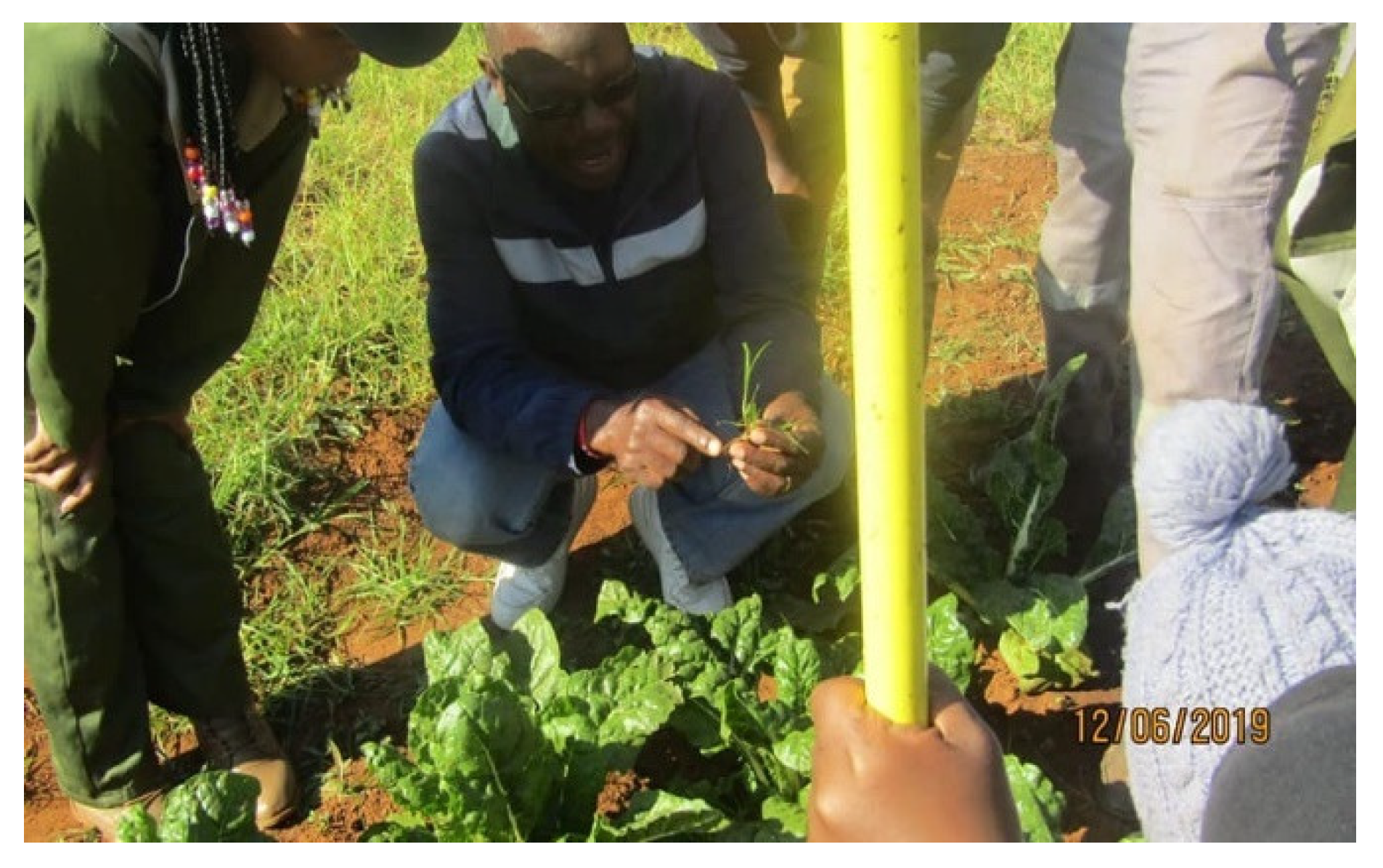
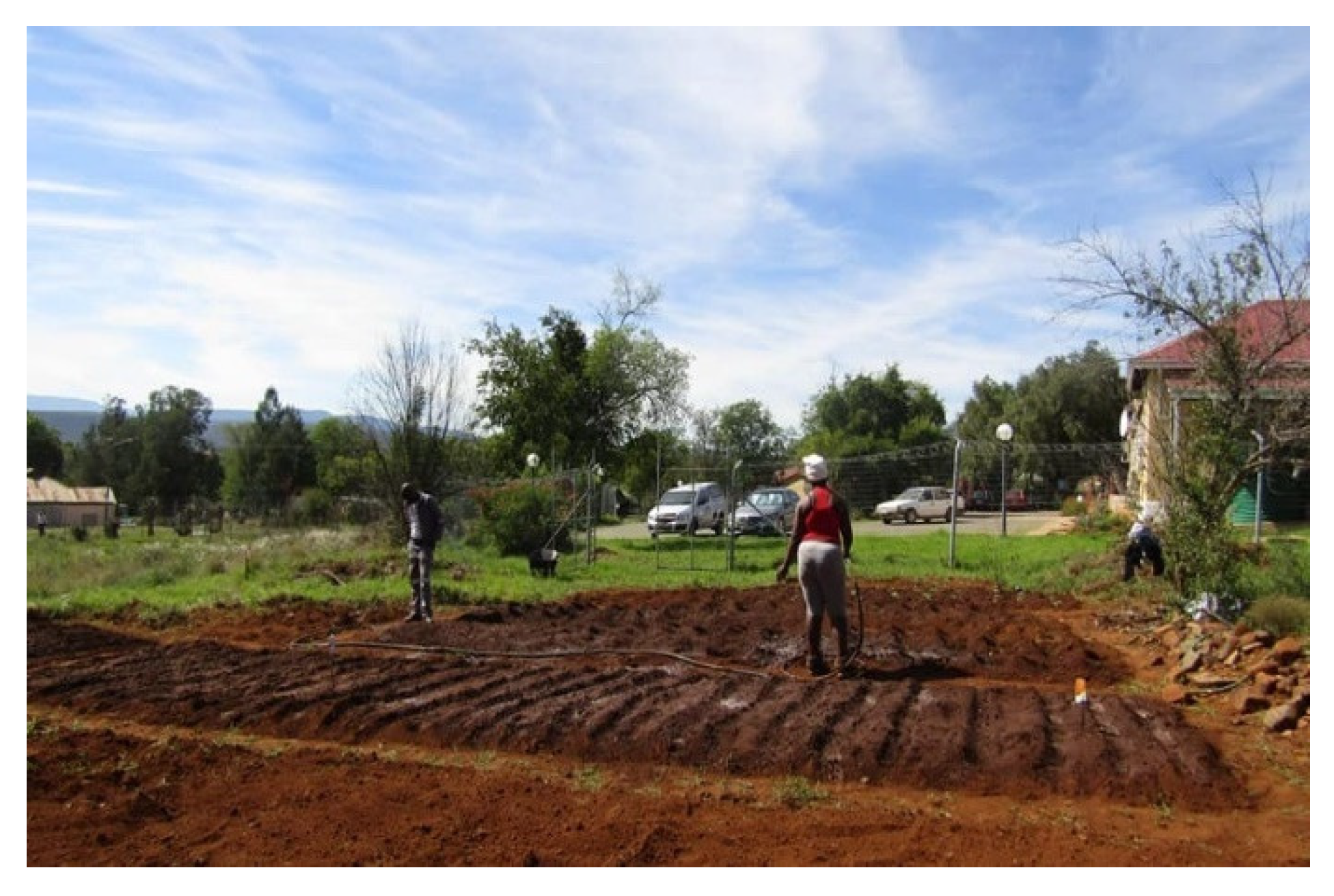

| 2018 Agricultural Extension Honours Class | ||||||
|---|---|---|---|---|---|---|
| Total Number of Students | Project Theme and Fb Page Links | Type of Ownership of Project | Number of People Who Like the Page | Numbers of Pictures Posted | Number of Videos Posted | |
| Gp 1 | 11 | Mhlobo Mbane Poultry Project Rural Engagement https://www.facebook.com/groups/1939790976331799/media (accessed on 2 February 2021). | Individual | 132 | 85 | 3 |
| Gp 2 | 11 | Gwebindlala Agricultural Extension Project https://www.facebook.com/groups/2122740477752736/media/videos (accessed on 2 February 2021). | Special school | 225 | 164 | 5 |
| Gp 3 | 11 | Vuk’uhambe Agricultural Community Engagement https://www.facebook.com/Vukuhambe-Agricultural-Community-Engagement-596620424030509/videos/?ref=page_internal (accessed on 2 February 2021). | Communal farm | 198 | 45 | 2 |
| 2019 Agricultural Extension Honours Class | ||||||
| Gp 1 | 8 | Bambanani Community Project https://www.facebook.com/Bambanani-Community-project-UFH-Ext-Honours-Students-2019-637595930044791/videos/?ref=page_internal (accessed on 2 February 2021).). | Public hospital | 204 | 109 | 1 |
| Gp 2 | 7 | Lovedale Community Project https://www.facebook.com/Lovedale-Primary-Community-project-1365785136919328/about/?ref=page_internal (accessed on 2 February 2021). | Community high school | 528 | 9 | 2 |
| Gp 3 | 7 | Sakhisizwe Development Project https://www.facebook.com/Sakhisizwe-Development-Project-1245599798932064 (accessed on 2 February 2021). | Special school | 342 | 110 | 8 |
Publisher’s Note: MDPI stays neutral with regard to jurisdictional claims in published maps and institutional affiliations. |
© 2021 by the authors. Licensee MDPI, Basel, Switzerland. This article is an open access article distributed under the terms and conditions of the Creative Commons Attribution (CC BY) license (https://creativecommons.org/licenses/by/4.0/).
Share and Cite
Yusuf, S.F.G.; Popoola, O.O.; Gwala, L.; Nesengani, T. Promoting University–Community Alliances in the Experiential Learning Activities of Agricultural Extension Postgraduate Students at the University of Fort Hare, South Africa. Sustainability 2021, 13, 10411. https://doi.org/10.3390/su131810411
Yusuf SFG, Popoola OO, Gwala L, Nesengani T. Promoting University–Community Alliances in the Experiential Learning Activities of Agricultural Extension Postgraduate Students at the University of Fort Hare, South Africa. Sustainability. 2021; 13(18):10411. https://doi.org/10.3390/su131810411
Chicago/Turabian StyleYusuf, Shehu Folaranmi Gbolahan, Oluwabunmi Oluwaseun Popoola, Lindokhule Gwala, and Thinandavha Nesengani. 2021. "Promoting University–Community Alliances in the Experiential Learning Activities of Agricultural Extension Postgraduate Students at the University of Fort Hare, South Africa" Sustainability 13, no. 18: 10411. https://doi.org/10.3390/su131810411
APA StyleYusuf, S. F. G., Popoola, O. O., Gwala, L., & Nesengani, T. (2021). Promoting University–Community Alliances in the Experiential Learning Activities of Agricultural Extension Postgraduate Students at the University of Fort Hare, South Africa. Sustainability, 13(18), 10411. https://doi.org/10.3390/su131810411






